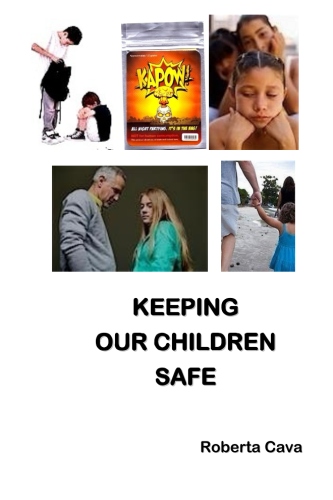Last month we discussed the release of my latest book entitled: Survival Skills for Supervisors and Managers – Guidelines for Business Success. This month we will discuss a topic covered in Roberta Cava’s book entitled: Keeping Our Children Safe

Self-Harm
I’m probably going to stir up some people with this newsletter, but felt I needed to address this issue.
Self-harm is linked to abuse, unwanted pregnancy and parental divorce. One in seventeen children is believed to hurt or self-harm itself. Behind these children is often a family in distress. Self-harm is the intentional cause to harm one’s own body. These include: deliberate self-harm, self-injury, self-mutilation, self-abuse, self-wounding, self-inflicted violence, para-suicide, non-fatal acts, and wrist cutting.
The person has low self-esteem and low self-worth. Self-harm includes:
Cutting.
Burning skin by physical means using heat.
Burning skin by chemical means using caustic liquids.
Punching hard enough to cause bruises.
Head banging.
Hair pulling from head, eyelashes, eyebrows and armpits.
Poisoning by ingesting small amounts of toxic substances to cause discomfort or damage.
Insertion of foreign objects.
Excessive nail biting to the point of bleeding and ripping cuticles.
Excessive scratching by removing top layer of skin to cause a sore.
Bone breaking.
Gnawing at flesh.
Wound interference to prevent wounds from healing thus prolonging the effect.
Tying ligatures around the neck, arms or legs to restrict the flow of blood.
Medication abuse without intention to die.
Alcohol abuse.
Illegal drug use.
Smoking.
Cutting and burning are among the most common forms of self-harm. Those who smoke and drink excessively might believe they are not consciously harming themselves, but they are.
There is also a strong correlation between eating disorders and self-harm. This is due to the fact that starvation, binge-eating and self-induced vomiting, overuse of laxatives and diuretics, are forms of self-harm, as are starvation, binge-eating and vomiting.
However, there are other forms of self-harm that we are seeing in many teen-agers. These are:
Tattoos: Having a small significant tattoo that has a special meaning to the owner is acceptable, but many take this to the extreme and this is another form of self-harm. Some could be naked, and one would think that they were fully dressed because of the excess of tattoos. How these individuals will look when they are seniors makes me shudder. Many even tattoo their neck, faces and hands so people will look at them. If I were an employer, I would refuse to hire these people because of their low self-esteem level.
Piercing: Infection is possible in any body piercing. For decades people have had single ear piercing, but now I see up to ten piercings in each ear. Some slowly increase the size of the piercing by placing larger and larger steel or acrylic plugs in the lower cartilage of their ears until some of the holes are up to 1.5 cm in circumference – some with a huge hole in the middle. When I see a person with a nose ring, I immediately think of bulls that are controlled by their master who put a rope through the nose ring to control the animal.
Then there are piercings in private parts of the body that must irritate the owner 24 hours a day. Again, why would anyone do this to themselves?
And why someone would go through the pain of having their tongue pierced is beyond me. Potential side effects of a tongue piercing include infection, disease transmission, excessive bleeding and nerve damage. Another possible side effect is endocarditis, which results when bacteria enters the bloodstream and the heart or its valves, become inflamed. Bacteria that breeds around the piercing can cause bad breath. Documented complications include infection causing brain and heart abscesses, hepatitis B and C, HIV, TB, and tetanus infections. Swelling of the tongue could cause an airway obstruction.
Roberta Cava is a best-selling author of non-fiction books. In total she has written 48 books; seven of them fiction and 41 non-fiction. She lives on the Gold Coast of Queensland in Australia.
To order her books:
Go to amazon.com then click ‘Books’ and under ‘search’ put ‘Roberta Cava’ (which will bring up all of her books).
To contact Roberta Cava or Cava Consulting, please send an e-mail to
